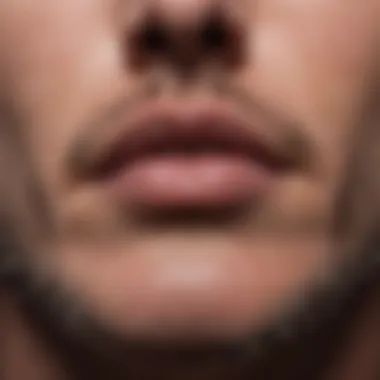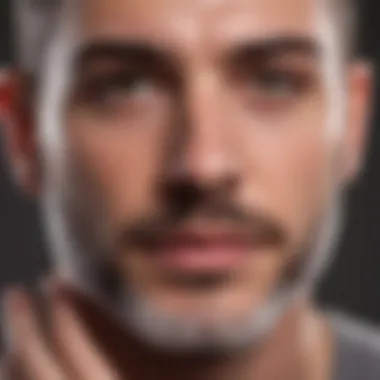Effective Strategies to Eliminate Razor Bumps on the Face


Intro
Razor bumps, medically termed pseudofolliculitis barbae, are common yet often vexing skin issues, especially for those who regularly shave their facial hair. These unsightly patterns can emerge from various factors, particularly ingrown hairs that disrupt the skin's surface and lead to inflammation. Every individual who has experienced these bumps understands not only the discomfort they cause but also their ramifications on one’s self-confidence.
Shaving might seem like a trivial aspect of personal grooming, yet it is intertwined with broader concerns about skin health and aesthetic appeal. This article aims to dissect strategies that promise relief and recovery from razor bumps. It reveals methods that are both immediate in their application and preventive in nature. Considering various skin types and hair textures is crucial when approaching this sensitive skincare topic. Along the way, we'll integrate actionable recommendations that extend to dermatological insight and product suggestions. This comprehensive guide serves to empower individuals to navigate the complexities of shaving while maintaining healthy skin.
Understanding Razor Bumps
Razor bumps are an important topic to grasp for anyone who shaves regularly, particularly those who like to maintain a well-groomed appearance. These bumps can detract from smooth skin, leading to a cycle of discomfort and self-consciousness. Recognizing the characteristics of razor bumps is a crucial step in preventing them.
What are Razor Bumps?
Razor bumps, medically recognized as pseudofolliculitis barbae, occur when hair grows back into the skin after shaving. This abnormal growth can result in inflammation, giving rise to small, raised patches on the skin. They often appear around the facial hair regions—namely, the beard area, neck, and cheeks. Understanding their formation is vital for cutting down occurrences, allowing individuals to strive for both aesthetic and comfort priorities in grooming routines.
Causes of Razor Bumps
The underlying factors contributing to razor bumps are multi-faceted. Common causes include:
- Ingrown Hair: When hairs do not rise properly from the follicle due to sharp razor blades, they can slip back into the skin, causing irritation.
- Curly Hair: For those with naturally curly hair, the tendency for these strands to bend backward after shaving increases their likelihood of becoming ingrown.
- Irritation due to Poor Shaving Techniques: Shaving against the hair grain or using old and dull razors can exacerbate skin irritation, leading to more bumps.
Identifying these causes helps tailor preventive strategies, significantly decreasing responsiveness to typical triggers.
Identifying Symptoms
Detecting razor bumps at early stages can lead to effective treatment. Symptoms include:
- Red raised areas around the follicles,
- Small pus-filled blisters,
- Tenderness or itchiness on the affected skin.
By familiarizing oneself with these signs, proactive measures can be ensures to lessen or form suitable removal techniques accordingly. Recognize that maintaining skin health extends beyond mere aesthetics. By understanding what razor bumps are, their causes, and how to identify their symptoms, one cultivates a surer pathway to smooth, irritation-free skin.
Shaving Techniques to Minimize Razor Bumps
Shaving techniques play a crucial role in preventing and reducing the occurrence of razor bumps. Understanding the appropriate approaches can not only enhance the shaving experience but also protect the skin. Engaging in improper techniques may inflame the skin or cause ingrown hairs. Striving for a technique-focused methodology grants the chance of a smooth shave, decreasing the conditions that contribute to razor bumps.
Choosing the Right Razor
Selecting the correct razor is fundamental. Different razors cater to varied skin types and hair textures. The versatility of a safety razor often outshines multi-blade options for many individuals. A single blade tends to cut the hair instead of pushing it below the skin surface.
Here are some tips for choosing the right razor:
- Assess your skin sensitivity. Softer blades may suit sensitive skin better.
- Evaluate hair type. Coarse hairs might need a more aggressive blade.
- Consider replacing blades regularly to prevent irritation.
Investing time in selecting the right razor aligns with the goal of reducing razor bumps effectively.
Proper Shaving Techniques
One of the first steps in your regimen should be to master proper shaving techniques. This does not just happen by accident; experience and mindful practice greatly influence skill. Begin with softening hairs before each shave, either through steam or warm water. This helps make it easier for the razor to glide over the skin smoothly.
Here are essential techniques to consider:
- Hold the razor at a 30-degree angle for better control.
- Use short, gentle strokes to minimize tugging and pulling on the hair.
- Rinse your razor often to prevent accumulated hair and product.
- Shave in the direction of hair growth to minimize irritation and avoid ingrown hairs.
Achieving effective techniques requires patient repetition, but the outcome can result in significant reductions in razor bumps.
Optimal Shaving Products
The quality of shaving products affects the entire process. The goals are simple: to lubricate the skin and provide a cushion against the blade. Good products safeguard not just your skin's surface but create an effective barrier that minimizes irritation. Opting for products destined for sensitive skin offers additional advantages.
Key product categories include:


- Shaving gels and creams: Select those formulated specifically for sensitive skin, rich with natural ingredients.
- Pre-shave oils: These create extra lubrication, reducing friction during the shave.
- Aftershave balms: These soothe the skin post-shave and help diminish irritation risco with soothing constituents.
By focusing on appropriate products, one can expect an enhanced shaving experience that optimally reduces any potential for razor bumps.
A proper selection in razors, techniques, and estimating the right products can form a multi-layered defense against razor bumps. Time invested here is quintessential for long-term ease and skin health.
Pre-Shaving Preparations
Pre-shaving preparations serve as a crucial step for anyone looking to minimize razor bumps. Proper preparation of the skin lays the foundation for a smoother shaving experience. It helps to soften facial hair and opens pores, resulting in reduced irritation. Moreover, all the efforts in dotting a well-groomed appearance can be futile if one neglects these essential steps. This section will detail the importance of effective pre-shaving practices, focusing on three main elements: cleansing your face, exfoliation, and using pre-shave oils.
Cleansing Your Face
The first step in any skincare routine is cleansing. This principle holds true for pre-shaving as well. Cleaning the face helps eliminate dirt, oil, and other impurities from the skin surface. This is important because a clean canvas allows for a smoother shave that reduces the so-called
Post-Shaving Care and Treatment
Post-shaving care plays a crucial role in minimizing the discomfort associated with razor bumps. After you have performed the shaving process, your skin is often sensitive. Applying the right treatments can soothe irritation, reduce redness, and promote healing. A tailored post-shaving routine is essential for maintaining healthy skin and preventing further occurrences of bane issues like razor bumps.
Soothing Aftershave Options
The application of aftershave is important in your routine. There are various soothing aftershave products designed to calma irritated skin and close the pores. Look for formulas that contain ingredients such as aloe vera, witch hazel, or calendula. These natural agents have properties known to reduce redness and inflammation. Selecting an aftershave with moisturising qualities can help you recover quickly from shaving.
When choosing an aftershave, consider the following factors:
- Skin Type: If you have oily skin, opt for a lightweight lotion. For dry skin, a thicker balm may be more appropriate.
- Fragrance: Products with artificial fragrances can aggravate sensitive skin. Choose unscented or naturally scented versions to minimize irritation.
A good tip is to apply aftershave right after shaving. This timing allows the product to penetrate sore areas effectively.
“Apply aftershave liberally and give your skin a moment to absorb it thoroughly.”
Moisturizing Techniques
Moisturizing after shaving is non-negotiable. Shaving can remove not just hair but also natural oils from your skin. To restore hydration, you must deploy effective moisturization techniques. Use products that are specifically designed for post-shave care. What to consider:
- Ingredients: Look for moisturizers with hyaluronic acid or glycerin, as they help draw moisture into the skin.
- Application: Gently apply your moisturizer without tugging on the skin to minimize irritation.
Regularly moisturizing helps create a barrier on the skin surface, which can fend off environmental aggressors while also keeping your skin supple.
It's wise to adopt this practice daily, not just after shaving but as part of a broader skincare routine. The benefits compound, enhancing your overall skin texture and reducing complications like razor bumps.
Treating Existing Razor Bumps
In case you already experience razor bumps, treating them promptly is essential to migraine. There are various topical solutions to help manage this condition effectively. Typically, creams containing ingredients like salicylic acid or benzoyl peroxide can address the bump while helping to correct skin tone.
To treat existing razor bumps:
- Clean the Area: Ensure that the areas affected are properly cleansed.
- Apply Treatments: Use a thin layer of the selected treatment directly onto the bumps. Be considerate not to choose harsh scrubs at this stage, as they can exacerbate irritation.
- Avoid Shaving Temporarily: Allow your skin time to recuperate. It might be wise to wait until the bumps resolve before you shave again.
Patience is vital as results often take a while to manifest.
Lifestyle Changes for Healthy Skin
Lifestyle choices significantly impact skin health, including the appearance of razor bumps. By implementing well-thought-out strategies, individuals can create an environment conducive to skin wellness. Engaging in dietary considerations, maintaining proper hydration, and employing effective stress management techniques enhance the skin's resilience and promote overall health. Thus, focusing on these changes is essential for men aiming to maintain smooth and healthy skin while engaging in regular shaving.
Dietary Considerations
Diet shapes the body’s response to various skin conditions, including razor bumps. A diet enriched with vitamins and minerals can aid in skin regeneration and healing. For skin health, certain nutrients should be prioritized:
- Omega-3 Fatty Acids: Found in fish like salmon and plant-based sources such as walnuts, omega-3 fatty acids help reduce inflammation.
- Zinc: This mineral supports skin repair and is plentiful in foods like chickpeas, nuts, and seeds.
- Vitamins A and E: These vitamins, present in colorful fruits and vegetables, play vital roles in skin maintenance. Carrots, spinach, and avocados are richer sources.
A balanced diet that avoids excessive sugars and processed foods can help minimize razor bumps. Sugar contributes to skin inflammation, which may worsen the condition. Instead, focus on whole foods, favoring dietary patterns that fuel both appearance and overall health.


Hydration's Role
Water is a fundamental part of skin health. Proper hydration contributes to the skin's elasticity, repairing and regenerating cells that combat injuries like shaved bumps. Missing hydration often leads to dry skin, which exacerbates irritation around hair follicles. Here are some simple rules regarding hydration:
- Drink ample fluids throughout the day.
- Herbal teas can be a good alternative if plain water is unappealing.
Aim for at least 8 cups of water daily; some may require more depending on activities and climate. In addition, while skincare products can aid in hydration externally, adequate internal intake is equally important for providing moisture to the dermal layers.
Stress Management Techniques
Stress directly impacts physical health, including skin health. High stress can trigger hormonal changes resulting in increased oil production and, subsequently, more razor bumps. To minimize this, stress reduction techniques should become part of a daily routine:
- Mindfulness Meditation: Practicing breath control can assist in centering thoughts. Taking a few moments of quiet reflection daily promotes inner peace.
- Physical activity: Regular exercise increases blood flow, aiding skin nourishment and reducing stress levels overall. Incorporating simple workouts such as jogging or yoga can be beneficial.
- Adequate rest: Sleep rejuvenates both mental state and the body. Aim for deep, restorative sleep each night to enable recovery and minimize stress-induced skin trauma.
Alternative Hair Removal Methods
In the quest for smooth skin unmarred by irritating razor bumps, exploring alternative hair removal methods offers a viable solution. Such approaches can significantly lessen the discomfort caused by traditional shaving techniques, and involve various treatments that yield smoother, longer-lasting results. It's essential to recognize that the choice of method may hinge on personal preferences, skin type, and budget considerations.
Laser Hair Removal
Laser hair removal operates by targeting hair follicles with concentrated light beams. This approach works to inhibit future hair growth by effectively destroying the hair follicles. It is considered a long-term solution as it significantly reduces the amount of hair regrowth over time. Individuals often prefer this method because it minimizes skin irritation, making it suitable for those susceptible to razor bumps. However, the cost can be higher compared to other methods, and depending on hair and skin type, multiple sessions are generally required for optimal results.
- Pros of laser hair removal:
- Cons of laser hair removal:
- Long-lasting results
- Minimal discomfort after treatment
- Greater precision targeting unwanted hair
- Costly initial investment
- Not all hair colors or skin types are suitable
Electrolysis Facts
Electrolysis is another alternative method for hair removal, using electrical currents to destroy hair follicles. Unlike laser hair removal, which targets areas of dark pigment in hair, electrolysis can be effective for all skin colors and hair types. This treatment is frequently recommended for those who experience persistent skin problems from shaving. It can take time to see the results and usually necessitates several sessions, which can be time-consuming. Each hair is treated individually, which offers a thorough approach but may make the process longer than someone may like.
- Key points about electrolysis:
- Safe and suitable for all hair and skin types
- Considered a permanent hair removal method
- Sessions may last from 15 minutes to over an hour for large areas
Depilatory Cream Options
Depilatory creams present a quick and other easily accessible method of hair removal. These creams dissolve hair at the skin level, leading to smoother skin without the hassle of shaving. They are particularly appealing to individuals who want to skip traditional shaving methods. However, it's crucial to perform a patch test to avoid potential allergic reactions or irritation, especially applying it to sensitive facial skin. Usage instructions should always be carefully followed.
- Benefits of using depilatory creams:
- Fast application and results
- Less likely to cause razor bumps
- Wide range of products available
Considering which method fits best depends on various factors including skin sensitivity, budget, and overall hair removal goals. Each option provides viable pathways forward, minimizing the threat of razor bumps effectively while catering to different personal preferences.
Consulting Professionals
Consulting professionals is a crucial strategy for managing razor bumps effectively. Individuals facing persistent issues with these bumps may find that home remedies and over-the-counter products are not sufficient. In such cases, a professional assessment becomes paramount.
Seeing a dermatologist can provide you with tailored advice. They specialize in skin, hair, and nail health, and can offer insights specific to your skin type and condition. Their expertise enables them to recommend effective remedies most suited for your situation.
Often, early intervention leads to better outcomes. Seeking help sooner rather than later can prevent further skin irritation.
When to See a Dermatologist
Recognizing the right time to consult a dermatologist is vital. If razor bumps persist despite trying various home remedies or products, it's time to take that step. Signs indicating the need for a professional include:
- Recurrent discomfort: If the bumps often cause pain or extreme irritation, it’s paying attention.
- Continuous outbreaks: Frequent reappearance of razor bumps implies an underlying issue.
- Kin inflammation: Increased redness, swelling, or pus should prompt a visit.
- Scarring: Detrimental changes to your skin from ongoing bumps may require professional help.


Hearing an expert’s opinion can reveal the proper management approaches as many factors can influence this condition.
Professional Treatments Available
Dermatologists offer various professional treatments. These methods go beyond standard shaving practices, presenting effective ways to address razor bumps:
- Laser hair removal: This technique offers a long-term reduction of hair follicles. This often leads to fewer bumps by stopping hairs from becoming ingrown.
- Chemical peels: These can exfoliate the skin surface, potentially treating existing bumps and removing dead skin cells.
- Prescription creams: Certain medications can aid in reducing inflammation and irritation.
- Microdermabrasion: A technique that uses tiny crystals to exfoliate the skin, which can alleviate bumps without harsh physical scrubs.
Each method has different effectiveness levels depending on skin type and needs.
Understanding Medication Options
If bumps become a chronic issue, dermatologists may prescribe medications. Understanding various options allows informed decisions:
- Topical antibiotics: Useful to address bacterial infections that could accompany ingrown hairs.
- Azelaic Acid: Effective in reducing inflammation and treating acne-like lesions arising from ingrown hairs.
- Retinoids: These work well in promoting skin cell turnover. They may help prevent clogged pores that lead to irritations.
- Corticosteroids: Useful for reducing inflammation, especially during flare-ups.
Carefully following the dermatologist's instructions ensures efficacy and safety. Personalized treatment can provide lasting relief.
Consulting trained professionals is vital in deciding a course of action. They streamline the process and contribute valuable insights, particularly for mitigating issues related to razor bumps.
Prevention Methods
Preventing razor bumps is crucial for maintaining skin health and ensuring a smoother shaving experience. These methods can help to significantly reduce the occurrence of bumps, allowing for increased confidence in one's appearance.
Establishing a Consistent Routine
Establishing a consistent shaving routine helps your skin adapt to the process, which can, in turn, minimize irritation. Aim to shave at the same time each day. Select a gentle cleanser to wash your face before instigating the shave. Ultimately, a predictable schedule reduces the chance of encountering unexpected flare-ups, making your shaving experience more comfortable.
Some men find success in utilizing the following practices:
- Choose the right time of day when skin is most relaxed, such as post-shower.
- Commit to same soap or cream for ensuring consistency.
- Regularly replace blades; this prevents tugging of hairs, promoting smooth results.
Avoiding Irritation Sources
Understanding what can provoke irritation is vital in your quest to avoid razor bumps. Common irritants include:
- Certain fabrics, like rough clothes that rub against your iskin tightly.
- Harsh chemicals in skincare products which may irritate the surface.
- Aggressive skin care routines that strip skin's natural oils.
To prevent these irritants from causing harm, choose soft, breathable clothing, and steer clear of skincare that contains alcohol or fragrances that trigger certain sensitivities. Additionally, avoid washing your face with hot water, as this can also contribute to discomfort. Softening the skin with cool, gentle water helps prepare it for the shave process.
Monitoring Skin Reactions
Another effective method in preventing razor bumps involves actively monitoring how your skin reacts after shaving. Take note of any redness or irritation. Different products and techniques can lead to varied consequences, therefore, maintaining a regular observation can inform choices surrounding any symptoms. Here are some steps to help:
- Keep a skincare journal; write about products used and reactions noticed.
- Switch one product at a time when experimenting; this allows for easier distinction in reactions.
- Assess each shaving session; document details from frequency of bumps to overall skin texture.
Exploring these small nuances enables refinement of your grooming routine, effectively limiting the risk of future bumps while enhancing the skin's response to shaving.
Implementing these preventative measures can foster a thoughtful approach towards facial grooming. Attention to detail in a personalized skincare regimen will lead the way to healthier, smoother skin.
Closure
The importance of concluding our examination of razor bumps cannot be overstated. Razor bumps, or pseudofolliculitis barbae as it is medically known, resonate deeply with individuals who take pride in their appearance. The discomfort, embarrassment, and potential skin health issues linked to razor bumps illustrate the need for preventive measures and proper care. This article sheds light on effective strategies ranging from correct shaving techniques to lifestyle adjustments actively beneficial in reducing or eliminating these nuisances.
Through a synthesis of our findings, we emphasize the critical points mentioned in the preceding sections. It's apparent that the right tools, added preparations, and post-shaving care are cornerstones of an effective strategy. Notably, embracing consistent regulations in skin care promotes long-term health and mitigates future razor bumps. Overall, this knowledge equips our audience with essential measures, reinforcing the principle that well-cared-for skin not only boosts confidence but contributes to overall health and well-being.
Summary of Key Takeaways
- Razor bumps emerge chiefly from improper shaving techniques and skin irritations.
- Key preventative actions include choosing the correct razor, implementing proper techniques, and maintaining post-shave routines.
- Lifestyle factors such as diet, hydration, and stress management play a significant role in skin health.
- Consulting skin care professionals becomes crucial if razor bumps persist, as they can prescribe effective treatments.
Encouragement for Ongoing Skin Care
Skin care is not a one-off activity but rather a continual commitment to one's health and appearance. As discussed, every small choice contributes to the overarching goal of maintaining blemish-free skin. Regular skin assessment and adjustments in routines are essential as our skin evolves with age, environment, and exposure. Maintaining an adaptable skin care approach ensures sensitivity to individual needs, leading to more personalized care.
Without a doubt, suggestions laid out in this discourse encourage actionable strategies for ongoing care. Try to adopt a mindfulness approach to daily routines. Note which products and methods suit one's specific skin conditions best. Caring for the skin goes beyond mere aesthetics; it brings a wealth of internal and external benefits that enhance well-being. Maintain openness to adjustments and improvements, and reap the rewarding results that come with dedication.
"Continuous effort, not strength or intelligence, is the key to unlocking our potential."















